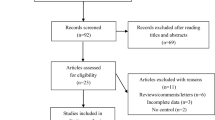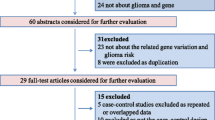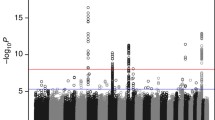Abstract
It is still unclear whether or not rs498872 at 11q23.3 increases the risk of developing glioma, because the previous literature has reported mixed findings. We carried out a meta-analysis with an aim to test the hypothesis that rs498872 contributes to the development of glioma. Eligible studies were identified through databases including the Chinese biomedical literature database, China national knowledge infrastructure, Science Direct, Embase and PubMed. The risk of glioma (OR and 95 % CI) was evaluated with the fixed-effects model or the random-effects model. Sensitivity analysis and publication bias tests were performed to check the reliability of our findings. Ten independent populations representing three ethnicities were analyzed in this study. We found 1.17–1.34-fold increased risk of glioma associated with rs498872 genotypes (OR 1.34, 95 % CI 1.22–1.46; OR 1.24, 95 % CI 1.14–1.35; OR 1.20, 95 % CI 1.10–1.31; OR 1.17, 95 % CI 1.08–1.27). In the stratified analysis by ethnicity, we also observed a significant increase in the risk of glioma in both Americans and Europeans. The results of our study support that the rs498872 polymorphism at 11q23.3 locus may be an important risk factor for glioma risk.



Similar content being viewed by others
References
Bondy, M. L., et al. (2008). Brain tumor epidemiology: Consensus from the Brain Tumor Epidemiology Consortium. Cancer, 113(7 Suppl), 1953–1968.
Siegel, R., et al. (2011). Cancer statistics, 2011: The impact of eliminating socioeconomic and racial disparities on premature cancer deaths. CA: A Cancer Journal for Clinicians, 61(4), 212–236.
Jemal, A., et al. (2009). Cancer statistics, 2009. CA: A Cancer Journal for Clinicians, 59(4), 225–249.
Preston-Martin, S., Chakrabarti, M. R., & Nervous system, I. (2006). Nervous system. In D. Schottenfeld & J. F. Fraumeni Jr (Eds.), Cancer epidemiology and prevention (pp. 1173–1195). New York: Oxford University Press.
Wrensch, M., et al. (1997). Familial and personal medical history of cancer and nervous system conditions among adults with glioma and controls. American Journal of Epidemiology, 145(7), 581–593.
Malmer, B., Henriksson, R., & Gronberg, H. (2003). Familial brain tumours-genetics or environment? A nationwide cohort study of cancer risk in spouses and first-degree relatives of brain tumour patients. International Journal of Cancer, 106(2), 260–263.
Hill, D. A., et al. (2003). Cancer in first-degree relatives and risk of glioma in adults. Cancer Epidemiology, Biomarkers and Prevention, 12(12), 1443–1448.
Scheurer, M. E., et al. (2007). Aggregation of cancer in first-degree relatives of patients with glioma. Cancer Epidemiology, Biomarkers and Prevention, 16(11), 2491–2495.
Wrensch, M., et al. (2009). Variants in the CDKN2B and RTEL1 regions are associated with high-grade glioma susceptibility. Nature Genetics, 41(8), 905–908.
Andersson, U., et al. (2010). A comprehensive study of the association between the EGFR and ERBB2 genes and glioma risk. Acta Oncologica, 49(6), 767–775.
Schwartzbaum, J. A., et al. (2007). An international case–control study of glutathione transferase and functionally related polymorphisms and risk of primary adult brain tumors. Cancer Epidemiology, Biomarkers and Prevention, 16(3), 559–565.
Sanson, M., et al. (2011). Chromosome 7p11.2 (EGFR) variation influences glioma risk. Human Molecular Genetics, 20(14), 2897–2904.
Stacey, S. N., et al. (2011). A germline variant in the TP53 polyadenylation signal confers cancer susceptibility. Nature Genetics, 43(11), 1098–1103.
Yang, T. H., et al. (2011). Combinations of newly confirmed glioma-associated loci link regions on chromosomes 1 and 9 to increased disease risk. BMC Medical Genomics, 4, 63.
Egan, K. M., et al. (2011). Cancer susceptibility variants and the risk of adult glioma in a US case-control study. Journal of Neuro-oncology, 104(2), 535–542.
Shete, S., et al. (2009). Genome-wide association study identifies five susceptibility loci for glioma. Nature Genetics, 41(8), 899–904.
Safaeian, M., et al. (2013). Joint effects between five identified risk variants, allergy, and autoimmune conditions on glioma risk. Cancer Causes and Control, 24(10), 1885–1891.
Wang, S. S., et al. (2011). Joint associations between genetic variants and reproductive factors in glioma risk among women. American Journal of Epidemiology, 174(8), 901–908.
Zintzaras, E., & Ioannidis, J. P. (2005). Heterogeneity testing in meta-analysis of genome searches. Genetic Epidemiology, 28(2), 123–137.
Higgins, J. P., et al. (2003). Measuring inconsistency in meta-analyses. BMJ, 327(7414), 557–560.
DerSimonian, R., & Laird, N. (1986). Meta-analysis in clinical trials. Controlled Clinical Trials, 7(3), 177–188.
Mantel, N., & Haenszel, W. (1959). Statistical aspects of the analysis of data from retrospective studies of disease. Journal of the National Cancer Institute, 22(4), 719–748.
Macaskill, P., Walter, S. D., & Irwig, L. (2001). A comparison of methods to detect publication bias in meta-analysis. Statistics in Medicine, 20(4), 641–654.
Zintzaras, E., & Lau, J. (2008). Synthesis of genetic association studies for pertinent gene-disease associations requires appropriate methodological and statistical approaches. Journal of Clinical Epidemiology, 61(7), 634–645.
Rice, T., et al. (2013). Inherited variant on chromosome 11q23 increases susceptibility to IDH-mutated but not IDH-normal gliomas regardless of grade or histology. Neuro-Oncology, 15(5), 535–541.
Di Stefano, A. L., et al. (2013). Association between glioma susceptibility loci and tumour pathology defines specific molecular etiologies. Neuro-Oncology, 15(5), 542–547.
Chen, H., et al. (2011). Association of sequence variants on chromosomes 20, 11, and 5 (20q13.33, 11q23.3, and 5p15.33) with glioma susceptibility in a Chinese population. American Journal of Epidemiology, 173(8), 915–922.
Rutherford, S., et al. (2007). A chromosome 11q quantitative-trait locus influences change of blood-pressure measurements over time in Mexican Americans of the San Antonio Family Heart Study. American Journal of Human Genetics, 81(4), 744–755.
Guo, C., et al. (1999). Allelic deletion at 11q23 is common in MYCN single copy neuroblastomas. Oncogene, 18(35), 4948–4957.
Jenkins, R. B., et al. (2011). Distinct germ line polymorphisms underlie glioma morphologic heterogeneity. Cancer Genetics, 204(1), 13–18.
NBSC, China’s Health Statistics Yearbook (2009). [in Chinese]. Peking, China: Peking Union Medical College Press. (http://www.moh.gov.cn/publicfiles/business/htmlfiles/zwgkzt/ptjnj/year2009/t-9.htm). (Accessed May 24, 2010) p. 254.
Verzat, C., et al. (1990). Influence of host sex on the growth of a human glioblastoma line in athymic mice. Neuropathology and Applied Neurobiology, 16(2), 141–151.
Plunkett, R. J., et al. (1999). Hormonal effects on glioblastoma multiforme in the nude rat model. Journal of Neurosurgery, 90(6), 1072–1077.
Ohgaki, H., & Kleihues, P. (2005). Epidemiology and etiology of gliomas. Acta Neuropathologica, 109(1), 93–108.
Author information
Authors and Affiliations
Corresponding author
Rights and permissions
About this article
Cite this article
Li, Z., Wang, Y., Guo, X. et al. Assessment of Glioma Risk Associated with an Inherited Variant at Chromosome 11q23. Cell Biochem Biophys 71, 69–75 (2015). https://doi.org/10.1007/s12013-014-0164-5
Published:
Issue Date:
DOI: https://doi.org/10.1007/s12013-014-0164-5




